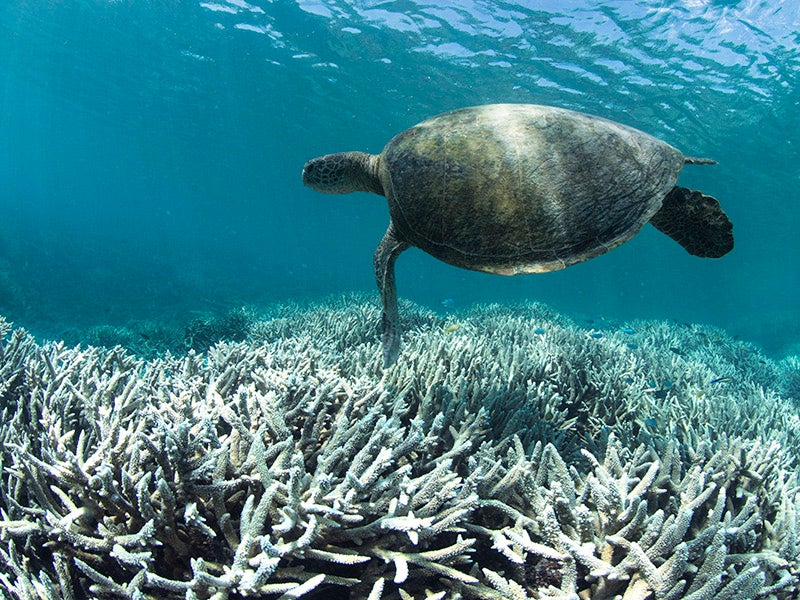Saving Coral Reefs from Death by Fossil Fuels
Earthjustice staff urge the World Heritage Committee to put pressure on big polluters to stop their single-minded pursuit of dirty fossil fuels, in order to protect humanity’s most precious places.

This page was published 8 years ago. Find the latest on Earthjustice’s work.
Around the world, coral reefs are flashing warning signs telling us that climate change is happening now and with frightening effects. Corals in Hawai‘i, New Caledonia, the Seychelles, Kiribati and elsewhere are bleaching and dying because of ocean warming and acidification caused by climate change. On the Great Barrier Reef in my home country of Australia, a staggering 22 percent of corals died last year—the worst coral die-off in recorded history. Climate change is driven by greenhouse gas pollution, the largest source of which is burning fossil fuels.
On the Great Barrier Reef in my home country of Australia, a staggering 22 percent of corals died last year—the worst coral die-off in recorded history.
But all is not lost; there’s still time to protect coral reefs from death by fossil fuels.
Recently, I travelled to Paris and Geneva with Earthjustice colleagues, a representative of Environmental Justice Australia and a scientific expert. We asked the World Heritage Committee to urge nations to act now to curb carbon emissions, in order to protect World Heritage-listed coral reefs and other iconic World Heritage sites from the impacts of climate change. Our meetings with members of the committee give me hope that the international community will protect our irreplaceable heritage sites by holding big polluting nations like the U.S. and Australia accountable for their contributions to climate change.
The World Heritage Committee is an intergovernmental body that implements the World Heritage Convention, an international agreement that commits countries to protecting some of the world’s most precious places. When governments fail to protect World Heritage sites within their borders, the committee can take action by pressuring the governments and focusing global attention on sites that are in danger.
During our trip, we introduced our new legal analysis, “World Heritage and Climate Change: The Legal Responsibility of States to Reduce Their Contributions to Climate Change—A Great Barrier Reef Case Study.” In this report, we show that nations with World Heritage-listed coral reefs must take serious and effective action to reduce their contributions to climate change. We then lay out a path for the World Heritage Committee to follow in order to encourage stronger action from the many nations that are failing to do their part, including by recommending that governments not approve or fund new coal mines or power plants.
Australia provides a case in point. It is custodian of the Great Barrier Reef—one of the world’s most complex ecosystems—and has primary responsibility for the reef’s protection. Yet it’s doggedly pursuing dirty fossil fuels by permitting the development of the some of the largest new coal mines in the world, which will contribute substantially to climate change and the further deterioration of the Great Barrier Reef. The annual emissions from mining and burning coal from just one of these proposed mines—the Carmichael mine—would be greater than the annual emissions of Sri Lanka, Bangladesh, Malaysia or Austria. Australia is already one of the highest per-capita emitters of greenhouse gases in the world, and it appears unlikely to meet its emissions-reduction goals under the international Paris Climate Agreement
[Australia] is custodian of the Great Barrier Reef—one of the world’s most complex ecosystems—and has primary responsibility for the reef’s protection. Yet it’s doggedly pursuing dirty fossil fuels by permitting the development of the some of the largest new coal mines in the world.
Australia has also permitted the expansion of a coal export terminal at Abbot Point, adjacent to the Great Barrier Reef World Heritage Area. The port expansion requires seabed dredging within the World Heritage area and will boost the number of industrial ships traversing the reef, increasing the likelihood of shipping accidents and spills. All of this is occurring while the Great Barrier Reef wastes away from the impacts of climate change.
When nations like Australia fail to take serious and effective action to reduce their contributions to climate change, the World Heritage Committee can and must take them to task, in order to protect World Heritage sites around the globe. The committee has the power, the opportunity and the responsibility to do so.
Earthjustice will continue to support the World Heritage Committee in its vital work to protect humanity’s most beloved places and to hold governments who put those places in danger to account.
The International Program partners with organizations and communities around the world to establish, strengthen, and enforce national and international legal protections for the environment and public health.